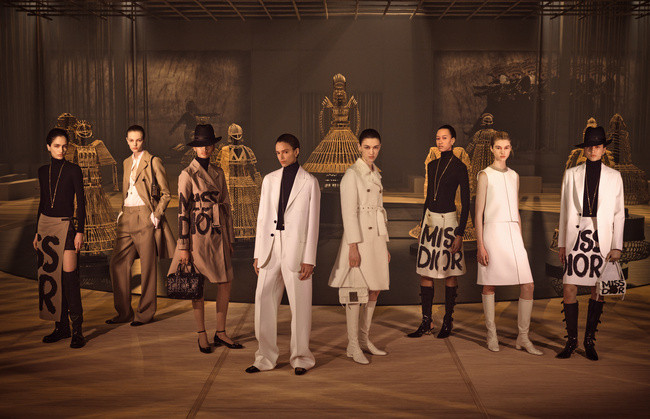Dior’s latest runway collaborator, artist Shakuntala Kulkarni, on her armours of strength and contradiction
The word ‘armour’ evokes images of a medieval knight clad in a hefty metallic visor and breastplate, perhaps with a touch of chainmail. The combatant is typically a man – the protector who needs protection. But Shakuntala Kulkarni reimagines both the form and the wearer with ‘Armour For The Brides’, a series of cane armatures that made their way to the Dior Fall/Winter 2024 show. The artist, whose work explores the relationship between the female body and urban public and private spaces, worked with creative director Maria Grazia Chiuri to mount the installations as a part of the runway set. These pieces serve to clothe, protect, and transform the body, but at the same time, cage it.
They are shaped to the body measurements of Kulkarni, who also wears and performs in them.
“Clothing can speak about power, freedom, dignity, and respect. Apart from that it can create a powerful female gaze. It can also be a metaphor for protecting the female body while at the same time trapping it, creating restrictions on free movement. I have used these metaphors to address the atrocities on the female body, which can cause discomfort, fear, and upset.”
Kulkarni is one in a long line of creative practitioners (including names such as Judy Chicago and Eva Jospin) that Grazia Chiuri has joined hands with to expand the feminist narrative she’s building for the luxury house. The Mumbai-based artist lets us in on this one-for-the books partnership.

GRAZIA: What was this collaboration like for you?
SHAKUNTALA KULKARNI: Collaborating with Dior under Maria Grazia Chiuri’s leadership was a great experience for me. I learned a lot from this project about designing, planning a large space, lighting, and sound, as well as choreography. The Bureau Betak team, which worked with Dior, was excellent. The set designer, technical designer, project manager, and I worked closely together. They had studied the images of my work, and through Zoom call discussions, they knew exactly what I wanted. They experimented with AI for the first time, enlarging the stills from my video to a 15 ft height, which was unbelievable. They had not used bamboo before too. Lighting through the bamboo grids was challenging. Special music was created by Michael in response to my work, which was also the context of the fashion show.

G: How do you integrate choreography from theatre, Indian dance forms, and yoga into your performances?
SK: My work is about balance/imbalance and movement, and I use different mediums to portray them. I have been involved with theatre and learned Indian dance since my younger days, and I practise yoga. Hence, it’s natural that my works are performative in nature, and I have incorporated live performance, video, and photo performance to expand the visual language by breaking the barriers of different art practices to address my concerns.

G: Let’s talk about the silhouettes within ‘Armour For The Brides’. I noticed that you created a lot of full-skirted, A-line silhouettes from the waist down. What were some creative decisions you had to make to arrive at these forms?
SK: My work is very organic in nature. It’s not pre-planned. I do drawings constantly, and something triggers off or I like a particular movement that the line has created, and the work gets built up on that.

G: What are the joys and challenges of working with cane? Why does this particular medium speak to you so much?
SK: I have always liked cane, but I had never thought of using it for my artwork. When I was working towards the armour and trying out different materials, I suddenly discovered cane as my material. I saw that the cane looks delicate, but it’s a strong creeper. It’s flexible and can be twisted and turned when heated. When joined together, it can deflect the gaze. I worked with a cane chair repairman from Mumbai and a cane thread jewellery maker from Assam. As the three of us worked together, we faced challenges such as how to fold the cane dress, what mechanism we could create to restrict movement, etc. We tried different methods, and we kept discovering different ways. Sometimes we tried cane hooks, sometimes joineries with cane thread, sometimes belts with woven thread. It was an organic process full of surprises and joy.
